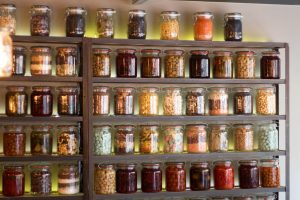Originally from the far north of the U.S., I am a southern transplant. I grew up in the land of the casserole, where if you ate beans it was from a can, most likely dumped into chili or a hotdish, and often with the words “pork ‘n” in front. I didn’t even know there were beans that weren’t named after a human organ until I moved away from home.
I know, wow.
And now, here we are, in central Texas and wouldn’t you know one of the plants most thriving and most likely to be grown by yours truly is beans – from cowpeas to a blue speckled heirloom to lima. I have come a long way in my bean journey.
One of the reasons beans are so plentiful in the south is because, well, they are cheap. But this is only sustainable in a climate that beans love (it’s hot here), and a culture that has passed down their bean-cooking know how so as to avoid those bland I-don’t-ever-want-to-eat-these-crunchy-boring-things-again.
So for those of you who may be interested I thought I’d post a very basic how-to cook beans tutorial. Whether you’re buying them super cheap and in bulk from the store or you’re harvesting your own crop, knowing how to cook good beans can go a long way in your kitchen.
If you’re worried about the hard-to-digest quality of beans see this post in which I share eight tips for cooking beans that are easier on the tummy.
 How-To Cook Dried Beans
How-To Cook Dried Beans
- Start with good beans. You want to get them from a source that has a good turnover so that you’re getting the freshest beans available. It is true that beans keep really well, but if they are too old they will never really soften up when you cook them.
- Start at least a day ahead of time. I know this sounds like a pain, but if you are menu planning anyways, just take a peak at the menu and see which days require some bean soaking.
- Sort and soak your beans. The day before you wish to eat them, you’ll want to dump your beans in a large pot, run your hands through them in search of the off bean or random pebble. Then cover then with at least twice as much water as beans, put a lid on the pot, and let them sit at least overnight.
- Drain and rinse. The next morning you’ll want to drain off the soaking water, rinse with fresh water, and either soak the rest of the morning or cook in fresh water or stock.
- Bring to a boil and skim. Once your beans are ready to cook cover them with water and put them over a high heat. Bring them to a boil and skim off any foam that rises to the top.
- Season and simmer for a long time. Once your beans are boiling and have been skimmed, turn the heat down to a simmer. Now it is time to flavor your beans. Any type of cured or smoked pork (or other animal) product is welcome here. Pieces of bacon, a ham hock, leftover ham, smoked turkey wings, and more will all give your beans a nice meaty, smoky flavor. Allumes such as onions and garlic are also great additions, as is a good amount of sea salt and any spices, like cumin and oregano for a Mexican flare. Once properly seasoned simmer those beans away for at least an hour or two, or until desired tenderness is reached.
Many traditional kitchens have had a pot of beans on the back burner of the stove most days of the week – whether the Mexican Grandmother or the Scandinavian housewife.
You can add them to soups or stews, serve them as a side dish to tacos or other Mexican food, eat for lunch in a tortilla or over rice along with sour cream and salsa, or eat them straight up with whatever you like. Beans are a great, nourishing, and inexpensive way to stretch quality meat and vegetables and fill little (and big) tummies.




 How-To Cook Dried Beans
How-To Cook Dried Beans

